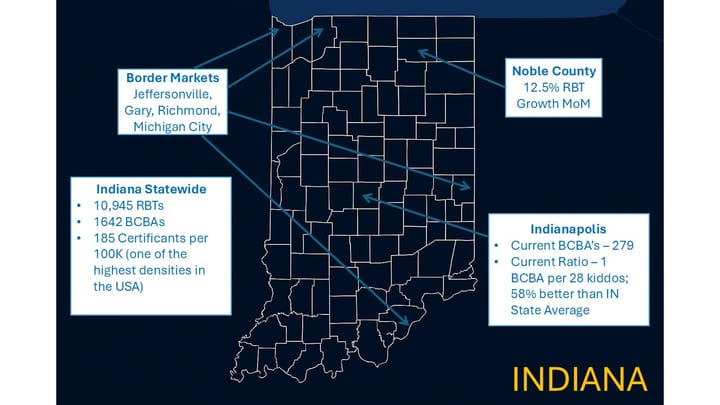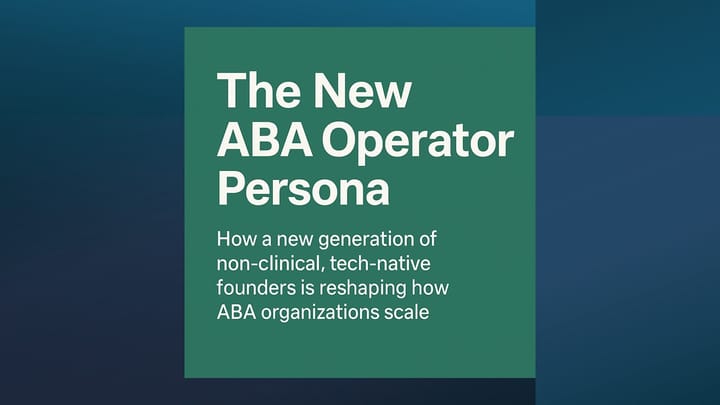ABA M&A won't pick up this year

Here’s my wager:
We won’t see meaningful acceleration in ABA provider M&A activity this year.
And I hope I’m wrong.
Why? Because if I do lose this bet, it could be a sign that the ABA industry is maturing—operating models aligning, payor variability stabilizing, and care delivery becoming less fragmented. It might mean the playbooks are finally reusable and the friction of post-deal integration is decreasing.
But I don’t think we’re there yet.
Why the Deals Still Aren’t Happening
Despite ongoing investor interest—and advisory groups like the Braff Group noting that autism services–related deals doubled in Q1 2025, contributing to a 53% rise in overall behavioral health M&A (BHB Article)¹—the bar was already so low that a “pickup” feels to me like a rounding error.
From what I’ve seen in my SCUBA tracking of the top 20 ABA providers, ownership hasn’t meaningfully changed all year. If a wave of consolidation is coming, it’s still out at sea.
And even as some signs point to stabilization—improved hiring, better retention, and resumed growth—most of that growth is coming from de novo expansion, not acquisition.
Here’s Why:
1. PE Firms Are Already Stuck Holding the Bag
Many PE-backed ABA providers are well beyond their intended hold periods—living in portfolios for 6 to 8 years instead of the planned 3 to 5. But even that pressure hasn’t spurred deal-making. Why? Because the buyers know what they’d be taking on: complexity, integration risk, and regulatory uncertainty.
Deals are being delayed in hopes of a cleaner story or a more forgiving market.
2. Care Models Are Still Too Fragmented
California leans toward home-based services. Georgia might be clinic-first. That shift alone changes everything: staffing, supervision, lease exposure, tech needs, and culture. Buying across state lines often means acquiring a completely different business model.
3. Operational Complexity Doesn’t Port Well
I’ve seen acquired entities keep different names and operations for a decade post-deal. Yes, we got them aligned on a PM platform—but aligning how they deliver care? That was a different story entirely.
Every acquisition is a tangle of payor exceptions, RCM workflows, and regulatory nuances. You’re not just buying a business—you’re inheriting a bespoke operational snowflake.
4. De Novo Is Still the Smarter Play
As the CEO of Gracent Mark Shalvarjian said in his interview with Rohit Verma: de novo is just better. You start with clean systems, your culture by default, and no fear of clawbacks or hidden skeletons.
It’s no surprise that much of the growth in ABA in the last 12 months has come from opening new clinics, not buying old ones.
5. Cultural Inertia Slows Everything Down
Many founders in this space are clinicians at heart. They didn’t build their businesses to flip them. That means acquiring culture buy-in can be just as hard as integrating systems. And if that inertia slows down post-deal momentum, the whole point of the acquisition can vanish.
6. The Risk/Reward Just Isn’t Balanced
You’re not just risking capital—you’re risking compliance gaps, unexpected audits, billing delays, and staff churn. A lot of providers are just starting to rebuild stability. Why risk it?
Why I Want to Be Wrong
Because if we start seeing repeatable, clean M&A in ABA, it would mean:
- Payers are becoming more predictable.
- Clinical and operational models are converging.
- Systems are more interoperable.
- And providers are confident enough to take smart integration risks.
It would be a sign of health.
A signal that we’re learning how to scale this sector sustainably—not just grow it in isolated pockets.
Until then, I’m betting on low deal volume and more de novo growth.
But I’ll celebrate if I lose.



